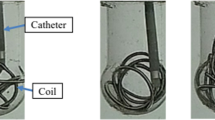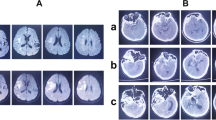Summary
There is still a relative silence in the literature on what policy should be followed in treating multiple aneurysms. The main risks are: bleeding of a formerly asymptomatic aneurysm during the haemodynamic tides of the peri-operative period; aneurysm(s) can be hidden on angiograms and tend to be overlooked easier in case of an already revealed aneursym; misjudgement of the ruptured one as a silent additional aneurysm, therefore left for second stage surgery.
This paper, based on a material of 330 operations for multiple aneurysms, focuses on these problems. It advocates the one stage complete repair of all lesions using both options of bilateral pterional craniotomies or the contralateral approach. But it also describes those silent aneurysms which safely could be clipped later. Hazards and disadvantages concerning the more aggressive surgery proved to be less significant than the natural history of multiple aneurysms represents.
Similar content being viewed by others
References
Adams HP, Kassel NF, Torner JCet al. (1981) Early management of aneurysmal subarachnoid haemorrhage. J Neurosurg 54: 141–145
Andrews RJ, Spiegel PK (1979) Intracranial aneurysms. J Neurosurg 51: 27–32
Berry RG, Alpers B, White JC (1966) The site, structure, frequency of intracranial aneurysms, angiomas, arteriovenous malformalities. Res Publ Ass Res Nerv Ment Dis 41: 40–72
Bigelow NH (1955) Multiple intracranial arterial aneurysms. Arch Neurol Psychiatry 73: 76–99
Boudouresques G, Meininger V, Hauw JJ (1980) Étude neuropathologique des hémorragies intracraniennes de l'adulte. Rev Neurol 136: 431–443
Chason JL, Hindman WM (1958) Berry aneursysms of the circle of Willis. Neurology 8: 41–44
Crawford T (1959) Some observations on the pathogenesis and natural history of intracranial aneurysms. J Neurol Neurosurg Psychiatry 22: 259–266
Crompton MR (1966) Mechanism of growth and rupture in cerebral berry aneurysms. Br Med J 1: 1138–1142
Dandy WE (1944) Intracranial Arterial Aneurysms. Ithaca, New York Comstock
Dinning TAR, Falconer MA (1953) Sudden or unexpected death due to ruptured intracranial aneurysm. Lancet 2: 799–801
DuBoulay GH (1965) Some observations on the natural history of intracranial aneurysms. Br J Radiol 38: 721–757
Fox JL (1983) Intracranial aneurysms. Springer, New York Berlin Heidelberg
Freytag E (1966) Fatal rupture of intracranial aneurysms. Arch Pathol 81: 418–424
Gurdjian ES (1958) Discussion. In: Wright IS, Millikan CH (eds) Cerebral Vascular Disease
Hamby WB (1952) Intracranial aneurysms. Thomas, Springfield, Ill
Hamby WB (1959) Multiple intracranial aneurysms. Aspects of treatment. J Neurosurg 16: 558–563
Heiskanen O, Martilla I (1970) Risk of rupture of a second aneurysm in patients with multiple aneurysms. J Neurosurg 32: 295–299
Heiskanen O (1981) Risk of bleeding from unruptured aneurysms in cases with multiple intracranial aneurysms. J Neurosurg 55: 524–526
Housepian Em, Pool JL 1958 A systematic analysis of intracranial aneurysms from the autopsy file of the Presbyterian Hospital 1914 to 1916. J Neuropath Exp Neurol 17: 409–423
Hudson CH, Raaf J (1968) Timing of angiography and operation in patients with ruptured intracranial aneurysms. J Neurosurg 29: 37–41
McCormick WF, Nofzinger JD (1965) Saccular intracranial aneurysms. An autopsy study. J Neurosurg 22: 155–159
McKissock W, Richardson A, Walsh L,et al (1964) Multiple intracranial aneurysms. Lancet 1: 623–626
Mount LA, Brisman R (1971) Treatment of multiple intracranial aneurysms. J Neurosurg 35: 728–730
Moyes PD (1971) Surgical treatment of multiple aneurysms and of incidentally-discovered unruptured aneurysms. J Neurosurg 35: 291–295
Pakarinen S (1967) Incidence, aetiology, and prognosis of primary subarachnoid haemorrhage. Acta Neurol Scand 43 [Suppl 29]: 1–128
Perneczky A, Knosp E, Vorkapic P, Czech Th (1985) Direct surgical approach to infraclinoidal aneurysms. Acta Neurocbir (Wien) 76: 36–44
Pool JL, Poots DG (1965) Aneurysms and arteriovenous anomalies of the Brain. Harper and Row, New York
Poppen JL, Fager CA (1959) Multiple intracranial aneurysms. J Neurosurg 16: 581–589
Rasmussen P, Busch H, Haase J,et al (1980) Intracranial saccular aneurysms: results of treatment in 851 patients. Acta Neurochir (Wien) 53: 1–17
Richardson JC, Hyland HH (1941) Intracranial aneurysms. Medicine 20: 1–83
Stehbens WE (1963) Histopathology of cerebral aneurysms. Arch Neurol 8: 272–285
Vajda J, Juhász J, Orosz E, Pásztor E, Tóth Sz, Horváth M (1986) Surgical treatment of multiple intracranial aneurysms. Acta Neurochir (Wien) 82: 14–23
Vajda J, Juhász J Pásztor E, Nyáry I (1988) Contralateral surgery to bilateral and ophthalmic aneurysms. Neurosurgery 22: 662–668
Walton JN (1956) Subarachnoid haemorrhage. Livingston, Edinburgh
Williams RR, Bahn R, Sayre G (1955) Congenital cerebral aneurysms. Proc Staff Meet Mayo Clin 30: 161–170
Wilson G, Riggs HE, Rupp C (1954) Pathologic anatomy of ruptured cerebral aneurysms. J Neurosurg 11: 128–134
Yaşargil MG, Smith RD, Gasser JC (1978) Microsurgery of the aneurysms of the internal carotid artery and its branches. Proc Neurol Surg 9: 58–121
Yaşargil MG (1984) Microneurosurgery. Thieme, Stuttgart
Author information
Authors and Affiliations
Rights and permissions
About this article
Cite this article
Vajda, J. Multiple intracranial aneurysms: A high risk condition. Acta neurochir 118, 59–75 (1992). https://doi.org/10.1007/BF01400727
Issue Date:
DOI: https://doi.org/10.1007/BF01400727




